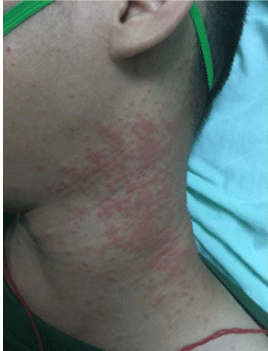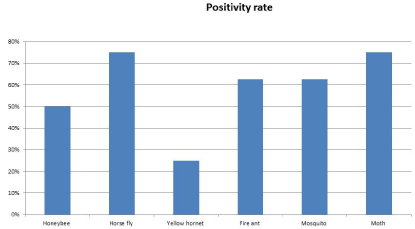
Case Report
Austin J Allergy. 2018; 5(1): 1033.
Caterpillar-Induced Protracted Anaphylaxis
Tsai MK1 and Yang DH1,2,3,4*
1Division of Rheumatology/Immunology/Allergy, Department of Internal Medicine, Taichung Armed- Forces General Hospital, Taichung, Taiwan
2Department of Laboratory, Taichung Armed-Forces General Hospital, Taichung, Taiwan
3Department of Medical Laboratory Science and Biotechnology, Central Taiwan University of Science and Technology, Taichung, Taiwan
4Division of Rheumatology/Immunology/Allergy, Department of Internal Medicine, Tri-Service General Hospital, National Defense Medical Center, Taipei, Taiwan
*Correspoing author: Deng-Ho Yang, Division of Rheumatology/Immunology/Allergy, Taichung Armed- Forces General Hospital, Chung Shan Road, Taichung, Taiwan, Republic of China
Received: May 09, 2018; Accepted: June 13, 2018; Published: June 21, 2018
Abstract
Caterpillars are mainly known to cause dermatitis and urticaria in humans. However, caterpillar-induced protracted anaphylactic reactions are rare and require urgent recognition and treatment. As caterpillar-induced dermatitis is ubiquitous, the life-threatening and possibly delayed reaction needs to be identified. We report a case of a 20-year-old male military recruit who had contact dermatitis after contacting a caterpillar and developed a protracted anaphylaxis.
Keywords: Anaphylaxis; Caterpillar; Allergy; Urticaria; Shock
Introduction
Anaphylaxis is the most severe life-threatening form of systemic allergic reaction, which appears within minutes to hours after exposure to a specific antigen. Most episodes of anaphylaxis begin rapidly and then resolve completely. However, in certain situations, some anaphylactic reactions resolve and recur hours later, or do not resolve completely for hours. Some even have delayed onset and protracted progression of symptoms [1,2].
Three typical models of anaphylaxis have been established [2], including monophasic, biphasic, and protracted anaphylaxes. First, monophasic anaphylaxis is the most common pattern and resolves either with therapy or naturally within 30 to 60 minutes. Second, biphasic anaphylaxis starts with a monophasic response, and an asymptomatic phase ensues within an hour or more. Then symptoms recur without reexposure to the causative antigen. Third, protracted anaphylaxis lasts for hours to days without complete boundary of the resolved symptoms.
Protracted anaphylactic reactions without early-phase reactions are rarely described and have been reported to occur only by various allergenic triggers such as foods [3], insect stings [4], and medications [5,6]. Cases of food-dependent, exercise-induced anaphylaxis have also been reported. Literatures on caterpillar-induced protracted anaphylaxis are rare. The present report describes the case of a 20-year-old male military recruit who had contact dermatitis after contacting a caterpillar and developed a protracted anaphylaxis.
Case Presentation
A 20-year-old male military recruit was visited by a team medic while outdoor training because of sudden onset of dyspnea. He only had a history of urticaria without regular medications, and he had no history of food or drug allergy or significant medical problems. He had no symptoms until about 15 hours before presentation. Papules and plaques with moderate itchiness occurred after he found a caterpillar on his left neck. On examination, dozens of equallysized plagues were found on the left side of his neck. The results of the remaining examinations were normal. A diagnosis of contact dermatitis was made, and topical chlorpheniramine maleate with lidocaine hydrochloride was prescribed to use twice daily. An hour before the onset of dyspnea, he called for help again because the pruritus aggravated. On examination, a few papules converted into hundreds of papules and plaques with a bleached center, bilaterally on the neck (Figure 1), where a localized, nonpitting edema was observed, and on the whole trunk, where no edema was observed. No significant findings were obtained in the rest of the examinations performed. He was told to increase the frequency of administration of the same ointment to four times a day. body, and dyspnea ensued. On examination, the patient was coherent, nonverbal, and drooling. His blood pressure, pulse, respiratory rate, and oxygen saturation while he was breathing ambient air were 86/66 mmHg, 125 beats per minute, 40 breaths per minute, and 92%, respectively. Auscultation of the lungs revealed generalized wheezing sounds. During transport to an emergency department, oxygen supplementation was administered through a nasal cannula at a rate of 5 L/min was administered while transporting to an emergent room.

Figure 1: Papules and plaques with a bleached center on the left side of the
neck.
Laboratory results included normal complete blood count with 2% eosinophils and arterial blood gas analysis result, and negative toxicology screening results. Chest radiography revealed mild infiltration in the bilateral lungs. After urgent management with fluid loading, intramuscular injection of epinephrine 0.5 mg, hydrocortisone 100 mg intravenously, and 5 mg of albuterol sulfate via inhalation, his blood pressure was increased to within the normal range. A dermatologist was consulted for dermatitis, who prescribed cyproheptadine 4 mg orally every 8 hours and hydrocortisone 200 mg intravenously every 8 hours. During admission, the tachypnea and pruritus were resolved, and no new symptoms occurred. Upon discharge, treatments were changed to oral prednisolone 15 mg three times a day. On day 5 of follow-up, his total immunoglobulin E (IgE) level was 622 IU/mL. On day 12, a multiple-allergy simultaneous test revealed two significant findings, including the house dust, mite Dermatophagoides farinae, and other unusual antigens. An ImmunoCAP Specific IgE test revealed a positive finding of moth (Table 1). At the 30- day follow-up, total resolution of the skin lesions without sequelae was observed. The patient had no recurrent symptoms of dyspnea and urticaria in the following 12 months.
Patient ID
Honeybee
Horse fly
Yellow hornet
Fire ant
Mosquito
Moth
test
-
+
+
+
+
+
Table 1: The presentation of circulating specific IgE levels in the patient.
Discussion
Anaphylaxis is the most severe life-threatening form of systemic allergic reaction, which has been estimated to be deadly in 0.7% to 2% of cases [7,8]. It appears within seconds to minutes after exposure to a specific antigen, and quick identification of the allergens is considerably important.
Generally, anaphylaxis is believed to arise from the activation of mast cells and basophils through a mechanism involving binding of IgE to those cells. Upon activation, mast cells and/or basophils quickly release mediators that include histamine, carboxypeptidase A, tryptase, and proteoglycans. Downstream activation produces arachidonic acid metabolites. Otherwise, tumor necrosis factor-a (TNF-a) is released as a preformed, and delayed-phase mediator with other cytokines and chemokines. These synergistic effects contribute to the overall pathophysiology of various anaphylaxis presentations, including biphasic or protracted anaphylaxis [9]. The underlying mechanism of protracted anaphylaxis has not been clearly studied, but we suspect that it could be mediated by the IgE pathway because our case showed high IgE level (622 IU/mL) even 5 days after the anaphylactic episode.
Caterpillars are mainly known to cause dermatitis and urticaria in humans, and caterpillar-induced anaphylactic presentations are rarely reported [10,11]. Two cases have been reported as follows: The first [10] case was a 12-year-old child who presented to the emergency department with systemic allergic reactions (pruritic rash, dyspnea, etc.), which were provoked soon after his attempt to extract a caterpillar nest from a pine tree. The dyspnea resolved with inhaled steroid treatment. The second [11] case was that of a 5-year-old boy who presented with skin lesions and respiratory symptoms after exposure to a caterpillar for about an hour. His symptoms were ameliorated by administering diphenhydramine and albuterol. The aforementioned two reported anaphylaxis cases after caterpillar contact were both monophasic, as symptoms appeared directly after caterpillar exposure. However, our patient exhibited protracted anaphylaxis, as systemic symptoms developed more than 15 h after contacting a caterpillar. This may be due to the species of the caterpillar or the age of the patient.
Moths are known to be the most common type of adult caterpillars, much more common than butterflies. As our patient could not remember the color or shape of the caterpillar he had contacted, we identified the moth antigen to prove that his allergic reaction was indirectly caused by a caterpillar. His laboratory reports showed elevated IgE level to the moth antigen, which was compatible with his contact history. Thus, we believe his anaphylactic reaction was caused by a caterpillar. We also assessed 6 insect antigens in 7 patients with chronic urticaria who lived in the Taiping area, where the present patient lived. The report showed high positivity rates for insect antigens (Figure 2). The prevalence of moth-related allergic reaction seemed common. Therefore, we suggest that patients with chronic urticarial should be routinely screened for moth antigens to detect any developing caterpillar-induced dermatitis, which may prevent anaphylaxis.

Figure 2: Increased insect-related specific IgE levels among patients living
around the Taiping area.
In patients with unidentified shock syndrome, anaphylactic shock should always be considered. Caterpillars are mainly known to cause dermatitis and urticaria in humans, but can also cause anaphylaxis, even in a protracted manner. Owing to our preliminary study, the prevalence may be underestimated. Medical staff should always keep the possibility of protracted anaphylaxis in mind, especially in children who are unable to describe their history precisely. Rapid recognition of progression of allergic contact dermatitis is important. Thus, we suggest that patients with disease progression should be treated with high-dose steroids immediately, which we did not do in our present patient to prevent protracted anaphylaxis and should be admitted for observation for more than 24 hours, especially in those with a history of contact with a caterpillar.
For patient protection, we suggest that patients with a history of protracted anaphylaxis, especially those with an allergic history (e.g, asthma, allergic rhinitis, and atopic dermatitis) or a high-exposure occupation (soldier, farmer, and lumberjack) should always bring a first-aid kit with epinephrine and be taught to perform self-injection [12].
References
- Stark BJ, Sullivan TJ. Biphasic and protracted anaphylaxis. The Journal of allergy and clinical immunology. 1986; 78: 76-83.
- Lieberman P. Biphasic anaphylactic reactions. Annals of allergy, asthma & immunology: official publication of the American College of Allergy, Asthma, & Immunology. 2005; 95: 217-226.
- Suzuki S, Nakamura Y, Kawano Y, Nishioka K. A case of “late-onset” anaphylaxis caused by fermented soybeans; Allergy. 2006; 55: 832-836.
- Reisman RE, Livingston A. Late-onset allergic reactions, including serum sickness, after insect stings. J Allergy Clin Immunol. 1989; 84: 331-337.
- Limb SL, Starke PR, Lee CE, Chowdhury BA. Delayed onset and protracted progression of anaphylaxis after omalizumab administration in patients with asthma. J Allergy Clin Immunol. 2007; 120: 1378-1381.
- Sakatani A, Doi Y, Matsuda T, Sasai Y, Nishida N, Sakamoto M, et al. Protracted anaphylaxis developed after peginterferon alpha-2a administration for chronic hepatitis C. World J Gastroenterol. 2015; 21: 2826-2829.
- Moneret-Vautrin DA, Morisset M, Flabbee J, Beaudouin E, Kanny G. Epidemiology of life-threatening and lethal anaphylaxis: a review. Allergy. 2005; 60: 443-451.
- Brown AF, McKinnon D, Chu K. Emergency department anaphylaxis: A review of 142 patients in a single year. J Allergy Clin Immunol. 2001; 108: 861-866.
- Peavy RD, Metcalfe DD. Understanding the mechanisms of anaphylaxis. Curr Opin Allergy Clin Immunol. 2008; 8: 310-315.
- Shkalim V, Herscovici Z, Amir J, Levy Y. Systemic allergic reaction to tree processionary caterpillar in children. Pediatr Emerg Care. 2008; 24: 233-235.
- DuGar B, Sterbank J, Tcheurekdjian H, Hostoffer R. Beware of the caterpillar: Anaphylaxis to the spotted tussock moth caterpillar, Lophocampa maculata. Allergy Rhinol (Providence). 2014; 5: 113-115.
- Sicherer SH, Simons FER. Quandaries in prescribing an emergency action plan and self-injectable epinephrine for first-aid management of anaphylaxis in the community. J Allergy Clin Immunol. 2005; 115: 575-583.